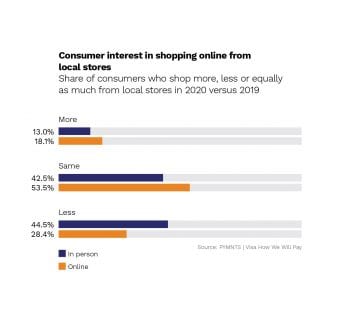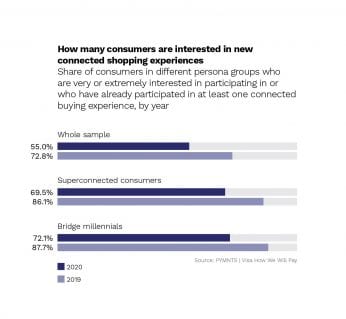
Snap Inc.’s ecosystem play has come into sharper and sharper focus as Q1 2021 has worn along. As PYMNTS reported last week, from a new partnership that will allow musicians to license their music on Snap directly, to a partnership with the NBA, to rolling out new developer eCommerce tools and acquiring New York City-based location data firm StreetCred, Snap’s expanding ambitions as a multi-channel super-app are fairly clear.
It is a big potential opportunity, as Snap’s large and growing user base is currently made up of 265 million mostly millennial and Generation Z active users who open the app an average of 30 times per day. An opportunity, Snap CEO Evan Spiegel confirmed on the firm’s last call with analysts, that Snap is committed to developing into a host of new revenue streams.
“We are reorganizing our product team around the five core platforms on Snapchat — Map, Communication, Camera, Stories and Spotlight — which we believe will drive increased focus and operational excellence as we transition each platform into a monetizable business,” Spiegel told analysts. “We successfully made that transition with Stories, which we monetize with full-screen vertical video ads, and with our Camera, where businesses can pay to promote their Lenses.”
And that effort has drawn corporate interest. Paul Anderson, Ikea’s U.S. interior design leader, told Adweek the firm’s choice to use Snap’s new AR functions to build a virtual escape room was a matter of creating new options for consumers in a disrupted world.
“For people who are a little apprehensive of visiting our stores during this time … it’s about trying to really meet people where they’re at,” he said.
That theme carries through most notably throughout the Snap ecosystem’s great commerce realignment. Because, when looking to the PYMNTS latest How We Will Pay report, Snap seems to be building not just to where its young consumer base wants to be online, but where they want to be across channels.
The New Digital Local
Being at home most of the time has motivated consumers to want to shop closer to home over the last year, according to PYMNTS data. Provided they can both find and shop with those merchants online.
Eighteen percent of surveyed consumers say they are going online more often to shop from local stores than they did in 2019, while 13 percent are shopping at their local stores’ physical locations more often than they did in 2019.
As for the why of shopping local, consumers want to help boost local economies and enjoy the immediacy that shopping local brings.
 Moreover, consumers report, merchants have upped the level of their digital game. Fifty-four percent of surveyed consumers who shop local report that neighborhood stores now allow them to pay for their purchases online, while 46 percent say their local stores have begun accepting contactless payments. Other new payment methods that consumers say their local merchants now accept include card on file and digital wallets, cited by 31 percent and 29 percent of surveyed consumers, respectively.
Moreover, consumers report, merchants have upped the level of their digital game. Fifty-four percent of surveyed consumers who shop local report that neighborhood stores now allow them to pay for their purchases online, while 46 percent say their local stores have begun accepting contactless payments. Other new payment methods that consumers say their local merchants now accept include card on file and digital wallets, cited by 31 percent and 29 percent of surveyed consumers, respectively.
In addition, the same survey shows, consumers’ tastes and preferences for the connected experiences and apps they are choosing to engage with are evolving as well. According to the survey, the new bar now for connected experiences to clear are now relevant and efficient: how those apps save the consumer time and reduce friction in their commerce journey.
 The majority of consumers (55 percent) are still interested in trying new connected experiences in the future, an interest that is particularly strong among younger consumers. Bridge millennial consumers are 30 percent more interested than the average consumer in store checkout experiences that use sensors to check out as they walk out and using visual searches to find, shop and pay for products online.
The majority of consumers (55 percent) are still interested in trying new connected experiences in the future, an interest that is particularly strong among younger consumers. Bridge millennial consumers are 30 percent more interested than the average consumer in store checkout experiences that use sensors to check out as they walk out and using visual searches to find, shop and pay for products online.
Those figures are interesting when one looks at Snap’s big acquisition of StreetCred to kick off 2021. The acquisition, according to reports, will allow for faster development of the Snap Map, which will let users look at public snaps from a given area and share with friends, the report stated. That feature was added last summer to the main Snapchat navigation bar and was drawing around 200 million users per month — the exact type of digitizing of the local experience that PYMNTS data reflects consumers are increasingly looking for.
The potential, according to Snap CEO Spiegel, is enormous as consumers are learning new and better easy to shop, not only online, but in person and in blended uses cases that are a little bit of both. Better digital tools, he noted in talks with analysts, are “transforming shopping into more of an experience, which hasn’t really been possible online historically.”
But today, it’s not only possible or merely plausible, it’s actually happening in real time all around. And while there are multiple attempts at building super app ecosystems to capture the shift, the winning ones will likely be the ones building not only to where customers are now, but where they are looking to go next.